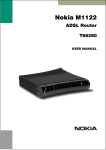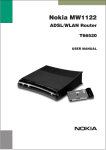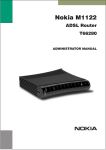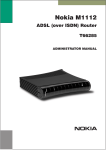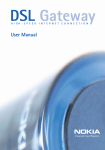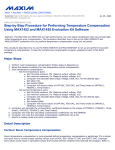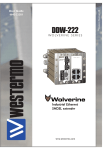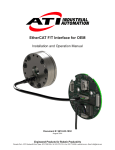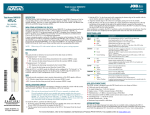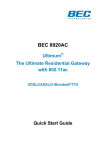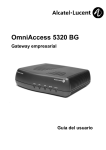Download Nokia M5122 Network Router User Manual
Transcript
Nokia M5122 ADSL Bridgeā T66250 USER MANUAL Nokia M5122 ADSL Bridge User Manual C33874.21 B0 02.11.2000 1 Introduction to Nokia M5122 Nokia M5122 is an ADSL bridge which enables high-speed Internet access and LAN interconnection. It increases the capacity of the already installed telephone lines used traditionally for telephone services. M5122 enables high-speed connections for homes and small offices. Figure 1 Nokia M5122 Nokia M5122 allows multiple PCs equipped with a 10Base-T Ethernet interface to be connected to a remote network via a Digital Subscriber Line Access Multiplexer (DSLAM) and an ATM access network. It acts as a bridge between the Ethernet LAN and ADSL/ATM network interfaces. An in-built 4-port hub allows easy home and small office network installation. C33874002SE_A0 E Copyright Nokia Networks Oy 1 Nokia M5122 User Manual 2 Installing M5122 Before installing M5122, you may want to familiarise yourself with the interfaces and indicator lights of M5122. From section 2.3, you will find a step-by-step installation procedure, which shows the physical installation of M5122. 2.1 Interfaces M5122 has one ADSL line interface and four Ethernet interfaces (10Base-T). It also has a Command Line Interface (CLI) for management purposes. The ADSL line interface is compatible with ITU-T G.992.1 specification. Power switch Mains connector Command line interface (CLI) Figure 2 2.2 ADSL line (DSL) Ethernet ports (ETH-1, ETH-2, ETH-3, ETH-4) M5122 back panel Indicator lights M5122 has eight indicator lights on the front panel: PWR, STA, COL, ETH-1, ETH-2, ETH-3, ETH-4, and DSL. STA indicator is red. Other indicators are green. 2 E Copyright Nokia Networks Oy C33874002SE_A0 Figure 3 DSL Off Blinks On ETH- Off On Blinks COL Blinks STA Off On PWR Off On C33874002SE_A0 M5122 front panel indicators GREEN ADSL link is down. ADSL connection is being established. ADSL link is up. GREEN Ethernet is down. 10Base-T Ethernet is functional. Receives traffic from Ethernet. GREEN Collisions on the Ethernet. Note, that it is normal that some collisions occur on the Ethernet. RED OK Hardware malfunction during startup. GREEN Power off. Power on. E Copyright Nokia Networks Oy 3 Nokia M5122 User Manual 2.3 Step-by-step installation procedures In this section, we present two installation procedures: ADSL data services and Telephone and ADSL data services. To use both telephone and ADSL services, you will need a POTS splitter. This manual gives installation example for a Nokia splitter T66270. In these examples, we assume that you have installed your Ethernet card properly and that your service provider has provided you with instructions how to set your PC’s networking options. ADSL data services 2. 1. 3. 4. Figure 4 5. M5122 with cables connected (ADSL services only) 1. Plug the mains power cord to a mains outlet. M5122 can be connected to an earthed socket outlet only. 2. Switch on M5122. The PWR indicator lights up. After a while, the red STA indicator blinks and then remains unlit. M5122 is now functional. 3. Connect the Ethernet cable between your PC’s 10Base-T connector and the Ethernet connector on the M5122 back panel (ETH-1, ETH-2, ETH-3, or ETH-4). 4. Switch on your PC. The indicator corresponding the Ethernet port you connected your PC to becomes green when your PC has started. This indicator blinks when there is traffic in the corresponding Ethernet port. 4 E Copyright Nokia Networks Oy C33874002SE_A0 5. Connect the ADSL line cable between the DSL connector on the M5122 back panel and the wall socket. After a while, the DSL indicator starts blinking. This indicates that the ADSL line is being established. When the DSL indicator remains lit, the line is functional. 6. During normal operation PWR and DSL indicators are lit and the Ethernet indicators of the active Ethernet ports blink or remain lit depending whether there is traffic or not. COL indicator may blink occasionally during normal operation. C33874002SE_A0 E Copyright Nokia Networks Oy 5 Nokia M5122 User Manual Telephone and ADSL data services with T66270 splitter 2. 1. 3. 7. 5. 4. 6. Figure 5 M5122 with cables and splitter (T66270) connected (Telephone and ADSL services) 1. Plug the mains power cord to a mains outlet. M5122 can be connected to an earthed socket outlet only. 2. Switch on M5122. The PWR indicator lights up. After a while, the red STA indicator blinks and then remains unlit. M5122 is now functional. 3. Connect the Ethernet cable between your PC’s 10Base-T connector and the Ethernet connector on the M5122 back panel (ETH-1, ETH-2, ETH-3, or ETH-4). 4. Switch on your PC. The indicator corresponding the Ethernet port you connected your PC to becomes green when your PC has started. This indicator blinks when there is traffic in the corresponding Ethernet port. 5. Connect the ADSL line cable between the DSL connector on the M5122 back panel and the splitter’s MODEM connector. 6. Connect the splitter cable between the splitter’s LINE connector and the wall socket. After a while, the DSL indicator starts blinking. This indicates that the ADSL line is being established. When the DSL indicator remains lit, the line is functional. 7. Connect the telephone to the splitter’s PHONE connector. 6 E Copyright Nokia Networks Oy C33874002SE_A0 8. During normal operation PWR and DSL indicators are lit and the Ethernet indicators of the active Ethernet ports blink or remain lit depending whether there is traffic or not. COL indicator may blink occasionally during normal operation. Now your M5122 has been connected and you can configure your PC’s networking options and check that the service works according to your service provider’s instructions. 2.4 Troubleshooting This section gives some tips for troubleshooting. Power (PWR) indicator is unlit. Make sure that power cord has been connected to a mains outlet and M5122 has been switched on. Red status (STA) indicator is lit Switch power off and then on again. If the STA indicator remains lit, the unit may be faulty. ADSL (DSL) indicator is unlit Make sure that the ADSL line cable has been properly connected between the DSL connector and the wall socket. Ethernet (ETH-) indicator is unlit Make sure that the Ethernet cable has been properly connected between your PC’s Ethernet interface and the M5122 ETH connector. Make sure that your PC is ON. You cannot access the Internet 1. Make sure that your M5122 is ON. 2. Check that the DSL indicator is lit. 3. Check that Ethernet indicator (ETH-1, ETH-2, ETH-3, or ETH-4) corresponding to the Ethernet interface you are connected to is ON. 4. Make sure that your PC’s networking functions have been configured according to your service provider’s instructions. C33874002SE_A0 E Copyright Nokia Networks Oy 7 Nokia M5122 User Manual 2.5 Installing M5122 on the wall M5122 can also be wall mounted. Figure 6 shows the installation procedure. 1. Drill two holes (6 mm in diameter) on the wall. The distance between the holes must be 155 mm. Insert the plugs to the holes and fix the screws. 2. Mount the modem on the wall as shown in Figure 6. 1. 6 mm 155 mm 2. Figure 6 8 Wall installation E Copyright Nokia Networks Oy C33874002SE_A0 3 Configuring M5122 Your service provider has configured your M5122 for the service. Do not change settings unless specifically asked by your service provider. You can change M5122 settings with an ordinary web browser, such as Microsoft Internet Explorer or Netscape Navigator. Use a PC connected to an ETH port of M5122 for configuration. In this case the corresponding ETH indicator should be lit. 3.1 Browser management The web configuration pages of M5122 can be accessed through the Ethernet and through the ADSL/ATM channels of M5122. In order to access the web management feature, the IP functionality must be activated and an IP address must be given to the corresponding interface. You can use your PC’s web browser software to access the web configuration pages in M5122. To access the web pages you must know the IP address of your M5122 or, alternatively, the “name” that your M5122 recognises. Note Before using your web browser for configuration, you must know the IP address or the name assigned to your M5122. There are three ways to find out whether to use a name or an IP address: D D D 3.1.1 Your service provider has given you an IP address for M5122. Your M5122 uses Dynamic Host Configuration Protocol (DHCP) and Domain Name Server. In this case the name is M5122. Your M5122 uses DHCP. In this case run winipcfg.exe (Windows 95) or ipconfig.exe (Windows NT). The IP address of M5122 is the Default Gateway address shown by the ipconfig program. Opening a connection To open a connection to the Nokia M5122: 1. Start your web browser. C33874002SE_A0 E Copyright Nokia Networks Oy 9 Nokia M5122 User Manual 2. Enter the name (’M5122’) or IP address of your Nokia M5122 in the browser’s Open Location field and press Enter. If you use the IP address, it has to be assigned to a local port or gateway interface (Vbridge). 3. Type in the username/password as requested. If no username/password is required, just click OK to proceed. The Nokia M5122 Main Page appears. 10 E Copyright Nokia Networks Oy C33874002SE_A0 3.1.2 Main Page Main Page is shown first when you use a web browser to connect to M5122. The currently shown page is shown highlighted on the list on the left. Clicking an item on the list (Service Providers, Local Network, Statistics, Restart, and Save Config) takes you to the corresponding page. Note When you make modifications to the configuration, remember to save the configuration if you want your changes to be active after a restart. Figure 7 Main page The Main Page shows you the statuses of the DSL line and Ethernet interfaces. Software and hardware versions and the serial number of M5122 are shown in the bottom of the page. C33874002SE_A0 E Copyright Nokia Networks Oy 11 Nokia M5122 User Manual 3.1.3 Service providers page You can view network connection information (ATM channel number, VPI and VCI values, and encapsulation) by selecting the connection from the pulldown list. Figure 8 shows the page with eth-llc encapsulation enabled and Figure 9 with PPTP tunneling enabled. Connection name (Figure 9) is used for identifying connections. The name can be changed and it can be 31 characters long. 12 Figure 8 Service Providers page with eth-llc encapsulation Figure 9 Service Providers page with PPTP tunneling enabled E Copyright Nokia Networks Oy C33874002SE_A0 3.1.4 Local network pages The Local Network page as three sub pages: Local ports, DHCP, and Routing. Local ports page On the Local Network Local Ports sub page you can assign an IP address to the Gateway port (Vbridge). Note When you click Apply, the IP address is changed immediately. If the IP address of the interface you are using changes the connection will be lost. You have to reconfigure the IP address of the accessing host. For example, in Windows programs winipcfg.exe or ipconfig.exe must be used first to release the old address and then to renew to request new address. Figure 10 C33874002SE_A0 Local Network Local Ports page E Copyright Nokia Networks Oy 13 Nokia M5122 User Manual DHCP page Note Use DHCP with PPTP tunneling only. On the Local Network DHCP subpage you can enable/disable Dynamic Host Control Protocol and set the Address ranges from which the addresses are distributed to the DHCP clients on your network. You can also set the Domain Name Server addresses here. Start address is the first address in the address range. The Range size defines how many addresses the range contains. Subnet mask is the subnet mask of the addresses in the range. Primary and Secondary DNSs set the domain name servers for the corresponding address range. Lease time defines how often the DHCP client must renew its lease. Domain name defines the domain name for the range. The DHCP server can be enabled towards LAN and Vbridge (gateway interface) ports. When the DHCP server is enabled, up to two scopes (address ranges) are automatically generated and bound to Vbridge interface. Two separate address ranges can be used if more than 253 addresses are required on the local subnet, if two non-contiguous ranges are needed, or if an additional router with DHCP relay is used on the local network. In Figure 11, scope (a) has been bound to Vbridge interface. When the address ranges are not defined, M5122 uses the default values for all DHCP parameters. The default values are: D D D D D D Start address is the interface IP address Subnet mask 255.255.255.0 Range size of up to 253 addresses starting from the interface IP address. DNS address is the interface IP address Lease time is 60 minutes Domain name is null string If at least one address range has been defined, then IP address, DNS, domain name and lease time, if defined, override the default values. 14 E Copyright Nokia Networks Oy C33874002SE_A0 Figure 11 C33874002SE_A0 Local Network DHCP page E Copyright Nokia Networks Oy 15 Nokia M5122 User Manual Routing page On the Local Network Routing sub page you can set static routes and enable/disable dynamic routing protocols (Routing Information Protocol versions 1 and 2). To enable dynamic routing select the Routing protocol version from the pull-down list and click the Apply button. RIP versions 1 and 2 are supported. Both v1 and v2 option enables the receiving of both RIPv1 and RIPv2 packets. To add a static route, type in the Destination network IP address, the Subnet mask of the destination network, and the Gateway and the Interface through which the destination network can be reached. Then click the Add new button. Figure 12 16 Local Network Routing page E Copyright Nokia Networks Oy C33874002SE_A0 3.1.5 Statistics page The Statistics page lets you view a selection of M5122 statistics. to view statistics of a particular function, click the corresponding button and the statistics view is opened on a separate window. Figure 13 C33874002SE_A0 Statistics page E Copyright Nokia Networks Oy 17 Nokia M5122 User Manual 3.1.6 Restart page On the Restart page, you can reset subsystems and restart M5122. Figure 14 18 Restart page E Copyright Nokia Networks Oy C33874002SE_A0 3.1.7 Save configuration page When you change the configuration, all configuration changes are activated immediately without restart/reload. However, the configuration will not be saved into the nonvolatile memory. If M5122 is restarted or powered down without saving the configuration, the old configuration will be restored. Clicking the Save configuration button saves the configuration into the nonvolatile memory and the old configuration cannot be restored through the web interface. Figure 15 4 Save configuration page Features M5122 can operate as a bridge between the Ethernet and the virtual channels of ADSL/ATM interfaces. 4.1 Bridging M5122 operates as a self-learning bridge supporting up to 1024 MAC addresses. Bridging in done between the Ethernet 10Base-T interfaces and the ATM/ADSL interface. 4.2 ATM and ADSL M5122 supports eight ATM/ADSL virtual channel connections (VCC). The factory default setting is one VCC with virtual path identifier (VPI) 0 and virtual channel identifier (VCI) 100. The ATM channel supports UBR (Unspecified bit rate) traffic shaping. The C33874002SE_A0 E Copyright Nokia Networks Oy 19 Nokia M5122 User Manual maximum transmit rate on the VCC is equal to the ADSL upstream capability. The ADSL transmission is based on the DMT line code. M5122 provides a DMT line rate up to 8 Mbit/s downstream and up to 800 kbit/s upstream. The DMT transceiver is rate adaptive and capable of providing faster rates over short distances or slower rates over long distances. The transceiver adapts itself to the line conditions and rate adaptation is done in steps of 32 kbit/s. The network operator can set the data rates as a part of the network management functionality provided by Nokia DSLAM. M5122 supports ATM over ADSL transmission ITU-T G.992.1 and ADSL Lite ITU-T G.992.2. The ADSL mode can be changed through the command line interface. 4.3 Dynamic Host Configuration Protocol Note Use DHCP with PPTP tunneling only. M5122 can act as a Dynamic Host Configuration Protocol (DHCP) server for the PCs on the end-user home network. In this mode, M5122 can assign up to 253+253 consecutive addresses from two separate address ranges (that is, 253 consecutive addresses per address range) to the PCs on the home network. Two separate address ranges can be used if more than 253 addresses are required on the local subnet, if two non-contiguous address ranges are needed or if an additional router with DHCP relay is used on the local network. M5122 can also act as a DHCP relay agent and relay the DHCP requests to an external DHCP server. 4.4 Point-to-Point Tunneling Protocol (PPTP) When PPTP local tunneling is used, a local network client initialises a PPTP-tunneled PPP connection (VPN) to Nokia M5122. The modem terminates the tunnel and all data from that terminated local PPTP tunnel will be forwarded to an assigned ATM VCC by using PPP over AAL5 encapsulation. Thus, each local PPTP tunnel requires an equivalent ATM VCC assigned to it restricting the total number of local PPTP hosts to 8. 20 E Copyright Nokia Networks Oy C33874002SE_A0 Local tunneling is used when there is a need to have one or more computers connected independently to different networks. For example, in remote work application, the rest of the family may be using the common ISP services and one or two family members need to gain access to their corporate networks. With local tunneling, these remote workers may be connected to a different network than the rest of the users. Local tunneling is activated using the PPTP client running, for example, in Windows. The destination IP address must be M5122 LAN/VBRIDGE IP address depending on the configuration. PPP packets within PPTP are mapped to the configured VCC. M5122 has three different ways to choose the ATM VCC that will be used for tunneling: D D D Automatic, chooses the first free VCC Chooses the VCC number using C:number, where number is from 1 to 8. C:number is typed after the M5122 IP address in PC’s PPTP client Connect To window (see Figure 1-1). Chooses the VCC number using N:name, where name is the VCCx description. N:name is entered after the M5122 IP address. Figure 1-1 4.5 Choosing the VCC2 for tunneling example Payload encapsulations The Ethernet frames are encapsulated in the ATM link by using RFC 2684 LLC/SNAP encapsulation. C33874002SE_A0 E Copyright Nokia Networks Oy 21 Nokia M5122 User Manual 4.6 Weighted Fair Queueing (Class of Service) As a Class of Service (CoS) function, M5122 supports Weighted Fair Queueing (WFQ) for each ATM VCC. The CoS function ensures that different IP traffic streams are treated fairly in the upstream (towards the Internet) direction. This may be necessary, in some cases, because the upstream capacity of the ADSL line is somewhat limited compared to the Ethernet bandwidth on the office or home LAN. The WFQ CoS function classifies IP traffic streams based on IP address, protocol and port fields. It is capable of identifying the IP stream from all supported payload encapsulation formats. 22 E Copyright Nokia Networks Oy C33874002SE_A0 5 Technical specifications Features ADSL Physical layer ANSI T1.413 Issue 2 (ANSI ADSL), ITU-T G.992.1 (ITU-T ADSL), and ITU-T G.994.1 (Handshake) compatible. ADSL line connector RJ-11 ATM over ADSL ATM connections PVC, up to 8 virtual circuits Service categories UBR Encapsulation RFC 2684 Ethernet LLC Ethernet interfaces (4) Ethernet 10Base-T, half duplex, 4-port 10Base-T hub Encapsulation DIXv2 (transmit), IEEE 802.3 and DIXv2 (receive) Ethernet connectors RJ-45 Bridging Bridging Self-learning bridge, bridges between all interfaces, possibility to disable bridging between WAN interfaces MAC table 1024 entries Class of Service Weighted fair queueing Command line interface (CLI) for local management Physical layer Electrically RS-232, TxD, RxD and GND signals Data format Asynchronous, 8+no parity Bit rate 9600 bps Flow control None CLI connector RJ-45 Dedicated ATM management channel Service categories UBR Encapsulations RFC 2684 Ethernet LLC, RFC 2684 IP LLC, PPP over ATM C33874002SE_A0 E Copyright Nokia Networks Oy 23 Nokia M5122 User Manual Features IP addressing Statically configured Through IPCP when PPP over ATM is used Routing Static routes RIPv1 Management protocols Telnet/TCP/IP for command line interface TFTP/UDP/IP for software and configuration download Management through payload Service categories UBR Encapsulations RFC 2684 Ethernet LLC Routing Static routes RIPv1 Management protocols Telnet/TCP/IP for command line interface TFTP/UDP/IP for software and configuration download Indicator lights 24 DSL ADSL line status ETH-1, ETH-2, ETH-3, ETH-4 Ethernet activity and status COL Ethernet collision STA M5122 startup error PWR Power on E Copyright Nokia Networks Oy C33874002SE_A0 5.1 Connectors and pin numbering Use these pin numberings when you want to obtain longer cables for your M5122. 1 8 Figure 16 ETH connector PIN Signal Direction M5122Ethernet 1 2 3 6 Rx+ Rx– Tx+ Tx– <– <– –> –> Table 1 1 C33874002SE_A0 Receive data + Receive data – Transmit data + Transmit data – Ethernet interface pin-out numbering 6 Figure 17 Table 2 MDI signal DSL connector PIN Signal 3 4 DSL1 DSL2 ADSL interface pin-out numbering E Copyright Nokia Networks Oy 25 Nokia M5122 User Manual 5.2 Mechanical construction and power supply M5122 is a stand-alone device which can also be wall-mounted. Mechanical construction Width 225 mm Height 65 mm Depth 230 mm Weight 1 kg Table 3 Mechanical construction M5122 has an in-built power supply. The characteristics of the mains connection are presented in Table 4. Mains connection Voltage 100 ... 240 VAC Frequency 45 ... 65 Hz Power consumption 8W Table 4 5.3 Mains connection Ambient conditions, EMC and safety Ambient conditions Operating temperature range 0 to 40°C Humidity 10% to 90%, non-condensing M5122 is for indoor use only M5122 can be connected to an earthed socket outlet only. EMC M5122 complies with the following specifications provided that the device is connected to an earthed socket outlet: Emission 26 EN55022: 1998 class B E Copyright Nokia Networks Oy C33874002SE_A0 5.4 Immunity EN55024: 1998 EMC EN300386-2: 1997 Overvoltage ITU-T K.21 Safety Safety EN60950 Copyright note HTTP server, Copyright 1996, 1997, 1998, 1999 Michiel Boland C33874002SE_A0 E Copyright Nokia Networks Oy 27 Nokia M5122 User Manual 28 E Copyright Nokia Networks Oy C33874002SE_A0





























